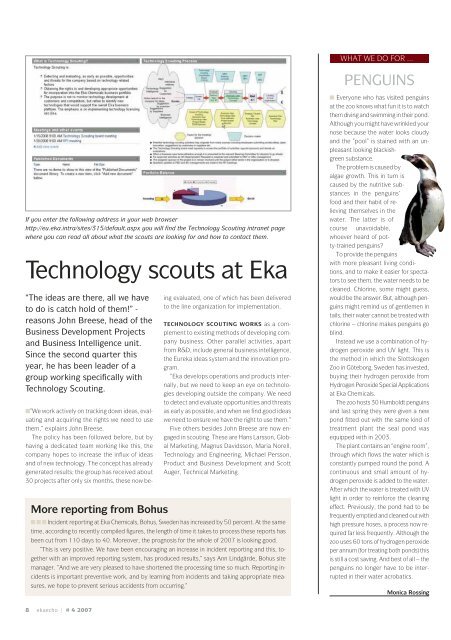when competitors became a team when competitors became a team
when competitors became a team when competitors became a team
when competitors became a team when competitors became a team
You also want an ePaper? Increase the reach of your titles
YUMPU automatically turns print PDFs into web optimized ePapers that Google loves.
If you enter the following address in your web browser<br />
http://eu.eka.intra/sites/315/default.aspx you will find the Technology Scouting intranet page<br />
where you can read all about what the scouts are looking for and how to contact them.<br />
Technology scouts at Eka<br />
“The ideas are there, all we have<br />
to do is catch hold of them!” -<br />
reasons John Breese, head of the<br />
Business Development Projects<br />
and Business Intelligence unit.<br />
Since the second quarter this<br />
year, he has been leader of a<br />
group working specifically with<br />
Technology Scouting.<br />
■”We work actively on tracking down ideas, evaluating<br />
and acquiring the rights we need to use<br />
them,” explains John Breese.<br />
The policy has been followed before, but by<br />
having a dedicated <strong>team</strong> working like this, the<br />
company hopes to increase the influx of ideas<br />
and of new technology. The concept has already<br />
generated results; the group has received about<br />
30 projects after only six months, these now be-<br />
More reporting from Bohus<br />
8 ekaecho | # 4 2007<br />
ing evaluated, one of which has been delivered<br />
to the line organization for implementation.<br />
TECHNOLOGY SCOUTING WORKS as a complement<br />
to existing methods of developing company<br />
business. Other parallel activities, apart<br />
from R&D, include general business intelligence,<br />
the Eureka ideas system and the innovation program.<br />
”Eka develops operations and products internally,<br />
but we need to keep an eye on technologies<br />
developing outside the company. We need<br />
to detect and evaluate opportunities and threats<br />
as early as possible, and <strong>when</strong> we find good ideas<br />
we need to ensure we have the right to use them.”<br />
Five others besides John Breese are now engaged<br />
in scouting. These are Hans Larsson, Global<br />
Marketing, Magnus Davidsson, Maria Norell,<br />
Technology and Engineering, Michael Persson,<br />
Product and Business Development and Scott<br />
Auger, Technical Marketing.<br />
■■ ■ Incident reporting at Eka Chemicals, Bohus, Sweden has increased by 50 percent. At the same<br />
time, according to recently compiled figures, the length of time it takes to process these reports has<br />
been cut from 110 days to 40. Moreover, the prognosis for the whole of 2007 is looking good.<br />
”This is very positive. We have been encouraging an increase in incident reporting and this, together<br />
with an improved reporting system, has produced results,” says Ann Lindgärde, Bohus site<br />
manager. ”And we are very pleased to have shortened the processing time so much. Reporting incidents<br />
is important preventive work, and by learning from incidents and taking appropriate measures,<br />
we hope to prevent serious accidents from occurring.”<br />
WHAT WE DO FOR ...<br />
PENGUINS<br />
■ Everyone who has visited penguins<br />
at the zoo knows what fun it is to watch<br />
them diving and swimming in their pond.<br />
Although you might have wrinkled your<br />
nose because the water looks cloudy<br />
and the ”pool” is stained with an unpleasant<br />
looking blackishgreen<br />
substance.<br />
The problem is caused by<br />
algae growth. This in turn is<br />
caused by the nutritive substances<br />
in the penguins’<br />
food and their habit of relieving<br />
themselves in the<br />
water. The latter is of<br />
course unavoidable,<br />
whoever heard of potty-trained<br />
penguins?<br />
To provide the penguins<br />
with more pleasant living conditions,<br />
and to make it easier for spectators<br />
to see them, the water needs to be<br />
cleaned. Chlorine, some might guess,<br />
would be the answer. But, although penguins<br />
might remind us of gentlemen in<br />
tails, their water cannot be treated with<br />
chlorine – chlorine makes penguins go<br />
blind.<br />
Instead we use a combination of hydrogen<br />
peroxide and UV light. This is<br />
the method in which the Slottskogen<br />
Zoo in Göteborg, Sweden has invested,<br />
buying their hydrogen peroxide from<br />
Hydrogen Peroxide Special Applications<br />
at Eka Chemicals.<br />
The zoo hosts 30 Humboldt penguins<br />
and last spring they were given a new<br />
pond fitted out with the same kind of<br />
treatment plant the seal pond was<br />
equipped with in 2003.<br />
The plant contains an “engine room”,<br />
through which flows the water which is<br />
constantly pumped round the pond. A<br />
continuous and small amount of hydrogen<br />
peroxide is added to the water.<br />
After which the water is treated with UV<br />
light in order to reinforce the cleaning<br />
effect. Previously, the pond had to be<br />
frequently emptied and cleaned out with<br />
high pressure hoses, a process now required<br />
far less frequently. Although the<br />
zoo uses 60 tons of hydrogen peroxide<br />
per annum (for treating both ponds) this<br />
is still a cost saving. And best of all – the<br />
penguins no longer have to be interrupted<br />
in their water acrobatics.<br />
Monica Rossing


